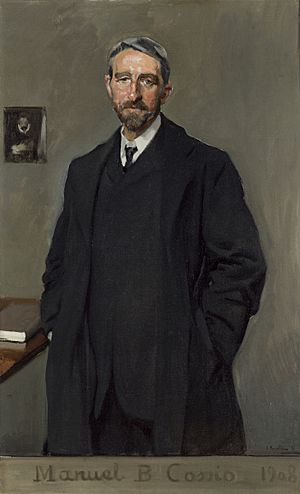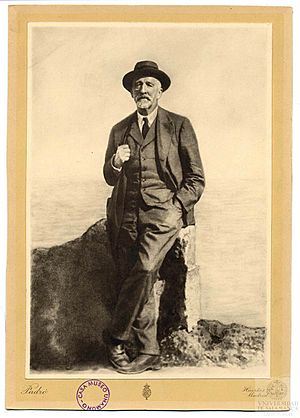Manuel Bartolomé Cossío facts for kids
Manuel Bartolomé Cossío (born February 22, 1857 – died September 2, 1935) was a very important Spanish teacher and art historian. He was born in Haro, a town in Spain. He joined the Institución Libre de Enseñanza (Free Institution of Education), which was a special school. There, he became the favorite student and close friend of Francisco Giner de los Ríos, who was a famous teacher.
Cossío later became the director of the Museo Pedagógico Nacional (National Pedagogical Museum). He also led the Misiones Pedagógicas (Pedagogical Missions), which were projects to bring education and culture to people across Spain. He is known as one of the most important figures in Spanish education from 1882 to 1935. He also wrote a huge book about the famous painter El Greco.
Contents
Manuel Cossío's Life Story
Manuel Cossío was the son of Natalia Cossío Salinas and Patricio Bartolomé Flores. His father was a judge. Manuel spent parts of his childhood in different towns like Aranda de Duero and Arévalo. These places always stayed special to him.
Early Education and Studies
In 1868, Manuel went to a boarding school in El Escorial. He received a strict religious education there. After his father passed away in 1871, Manuel moved to Madrid with his mother. He was only 14 years old.
In Madrid, he started studying Philosophy, Literature, Art History, and Archaeology at the Central University. He made friends with many important people who would become famous writers and thinkers. In 1874, he earned his degree in History of Philosophy.
Joining the Free Institution of Education
The Institución Libre de Enseñanza (ILE) was founded in 1876. This school was different because it focused on new ways of teaching. Manuel Cossío was one of its very first students. After his mother and sister passed away, he dedicated himself completely to the ILE.
He soon became an assistant teacher and then a primary school teacher at the ILE. He became very close to Francisco Giner de los Ríos, who was his mentor. Giner sent Cossío to study in Bologna, Italy, in 1879.
Learning and Traveling in Europe
In 1880, Cossío took courses in History, Art, and Education at the University of Bologna. He also traveled a lot through Italy, Switzerland, France, Holland, and Belgium. He even attended an international education meeting in Brussels. There, he helped present the ideas of the Free Institution of Education to people from other countries.
When he returned to Spain, he continued teaching at the ILE. In 1882, he became a professor of Art History in Barcelona. He also visited Portugal.
Leading the National Pedagogical Museum
In 1883, Manuel Cossío became the director of the Pedagogical Museum of First Education. This museum later became the National Pedagogical Museum. He stayed there until he retired in 1929. He had many new ideas for the museum, like creating traveling libraries for schools and setting up school vacation camps.
In 1886, Cossío traveled again to France, Belgium, Holland, and Great Britain. He went with Giner de los Ríos and some students from the ILE to visit important schools.
Family Life and Important Works
In 1893, Manuel Cossío married Carmen López Viqueira. They had two daughters, Natalia and Julia. Sadly, his wife Carmen later faced health problems.
In 1901, Cossío became a professor of General Pedagogy at the National Pedagogical Museum. He gave an important speech in 1905 about "The teacher, the school and the teaching material." This speech helped change how schools worked in Spain.
In 1908, he published his famous book about the painter El Greco. This book helped people understand and appreciate El Greco's art much more. It became a key book for anyone studying the painter. The artist Joaquín Sorolla painted two portraits of Cossío that same year.
Cossío continued to travel and learn. In 1909, he visited schools in Germany and Switzerland. His daughters even went to German schools during this time. In 1913, King Alfonso XIII met with Cossío because of his important work at the National Pedagogical Museum.
Later Years and Legacy
After his mentor, Giner de los Ríos, passed away in 1915, Cossío became ill. He moved to different places to recover. His eldest daughter, Natalia, married Alberto Jiménez Fraud, who also worked at the Residencia de Estudiantes (Students' Residence) in Madrid.
In 1926, Cossío helped write the educational plan for the Free Institution of Education. He retired in 1929. As a tribute, his students published a book of his writings. In 1930, he was named honorary director of the National Pedagogical Museum.
One of his last joys was seeing the "Cossío School" open in Valencia in 1930. In 1931, he became the president of the Misiones Pedagógicas. These missions were a dream he and Giner had worked on for many years. They aimed to bring culture and education to rural areas of Spain.
Manuel Cossío passed away on September 2, 1935, at the age of 78. He was buried in the civil cemetery of Madrid, in the same grave as his friends and fellow educators, including Francisco Giner de los Ríos. Many people, including intellectuals, workers, and students, came to his burial to honor him.
Manuel Cossío's Ideas and Contributions
Manuel Cossío believed that education should help children think for themselves. He said:
"The whole world must be, from the first moment, an object of attention and a matter of learning for the child... Educate before instructing; make the child, instead of a warehouse, a cultivable field."
This means he thought it was more important to teach children how to learn and explore, rather than just filling their minds with facts.
Here are some of the important changes and ideas that came true thanks to his efforts:
- In 1883, he pushed for equal pay for male and female teachers, which was very advanced for its time.
- He helped create school vacation camps in 1887.
- He worked to improve school materials, libraries, and school buildings.
- He guided the creation of the Pedagogical Missions, which started in 1932. These missions sent groups of teachers, artists, and librarians to small towns and villages. They brought books, art, music, and plays to people who didn't have access to them.
Cossío also believed in learning from his students:
"...from my disciples I have learned... more than from my teachers."
Portraits and Tributes
Many people who knew Manuel Cossío wrote about his personality. The poet Juan Ramón Jiménez described him beautifully, comparing him to a calm landscape. Julián Besteiro, one of his students and a politician, remembered him as a caring friend and a hero who inspired everyone.

Selected Writings by Manuel Cossío
Manuel Cossío wrote many articles and books about education and art. Here are a few examples:
On Education
- "Manual work in primary school" (1883)
- "On the teaching of drawing at school" (1901)
- The Teacher, the school and the teaching material (1906)
- "On aesthetic education" (1887)
- Program. Free Institution of Education (1910)
- Primary Education in Spain (1915)
On Art History
- El Greco (1908)
- What is known about the life of El Greco (1914)
- The Burial of the Count of Orgaz (1914)
- Excursion to Toledo (1925)
Images for kids
See also
 In Spanish: Manuel Bartolomé Cossío para niños
In Spanish: Manuel Bartolomé Cossío para niños





